Who Is Eirik Horneland?
Not much is capable of exciting football tactics enthusiasts more than a coach whose presence with a team delivers noticeably elevated performance levels via a distinct, characteristic playing style.
In Norway, this has been evident over the last few years at three-time Norwegian top-flight champions SK Brann during the tenure of Eirik Horneland.
This compelling 49-year-old tactician’s coaching career began just as the curtain was drawn on the former defender’s playing career with Haugesund, as he became Jostein Grindhaug’s assistant manager with the same club from 2010 to 2014.
After a few years of honing his skills with the Norwegian national team underage setup, he returned to Haugesund with sharpened tools to take the managerial hot seat for himself.
He enjoyed a couple of solid campaigns, which earned him a move to Eliteserien giants Rosenborg from the 2019 campaign.
Sometimes, for managers as much as for players, certain moves just don’t work out — and timing often has a lot to do with that.
In the case of Horneland and his Rosenborg endeavour, it was most likely a case of a big opportunity coming slightly too early and a lack of necessary preparation meeting what was an excellent chance for the Haugesund-born coach to showcase the managerial skills he has to offer on a big stage.
Horneland managed to guide Rosenborg to third place in 2019 — a finishing position the club has failed to beat in any of the four full seasons to have culminated since then.
He was replaced midway through the 2020 campaign, and he went back to the drawing board, taking some time to learn from his mistakes and resharpen his tools in his next role as Kåre Ingebrigtsen’s assistant with Brann for half of the 2021 campaign until he replaced Ingebrigtsen midway through that season.
While Horneland was unable to save Brann from relegation that term, the club stuck with him—a decision that’s proven to be extremely wise.
Since that 2021 relegation, Horneland has spearheaded a high-pressing, high-intensity tactical revolution at Brann that has turned them from relegation fodder into top-tier title contenders in a very short space of time.
This tactical analysis will provide an in-depth analysis of this key aspect of Horneland’s tactics: his intense pressing principles.
We’ll go into detail on exactly how Brann’s 49-year-old mastermind has reinvented his side since fully taking charge of the first team and why his tactics have been so successful.
Eirik Horneland SK Brann Tactics Transformation Through Data
Before analysing how Horneland’s side play, let’s look at the effect his presence and, as such, his tactical vision have had in such a short time period at Brann Stadion.
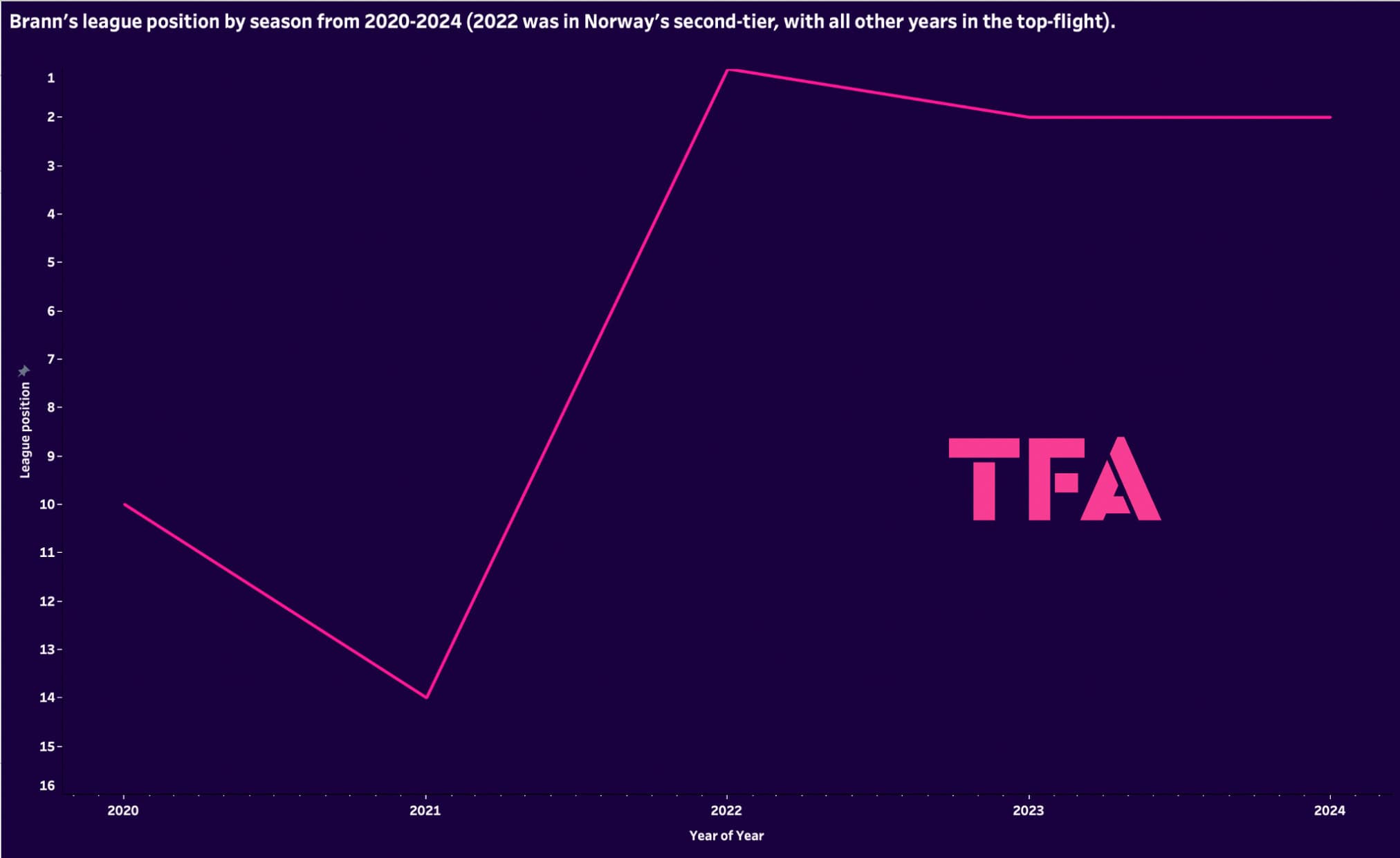
Firstly, bearing in mind that Brann spent the 2022 season in Norwegian’s second-tier — OBOS-ligaen — figure 1 illustrates how their domestic campaigns have gone from 2020 to 2024.
Under Horneland, a reinvigorated club bounced straight back from their 2021 relegation as second-tier champions in 2022.
Not satisfied with their work there, however, Brann astonishingly went on to finish second in their first season back in the top flight last term, ending up nine points off Bodø/Glimt.
This season, at the time of writing, the club, which is currently on course to compete in the UEFA Europa Conference League this season, sit second on the table again.
Second place in Eliteserien was something Brann hadn’t achieved since 2016, prior to Horneland’s arrival.
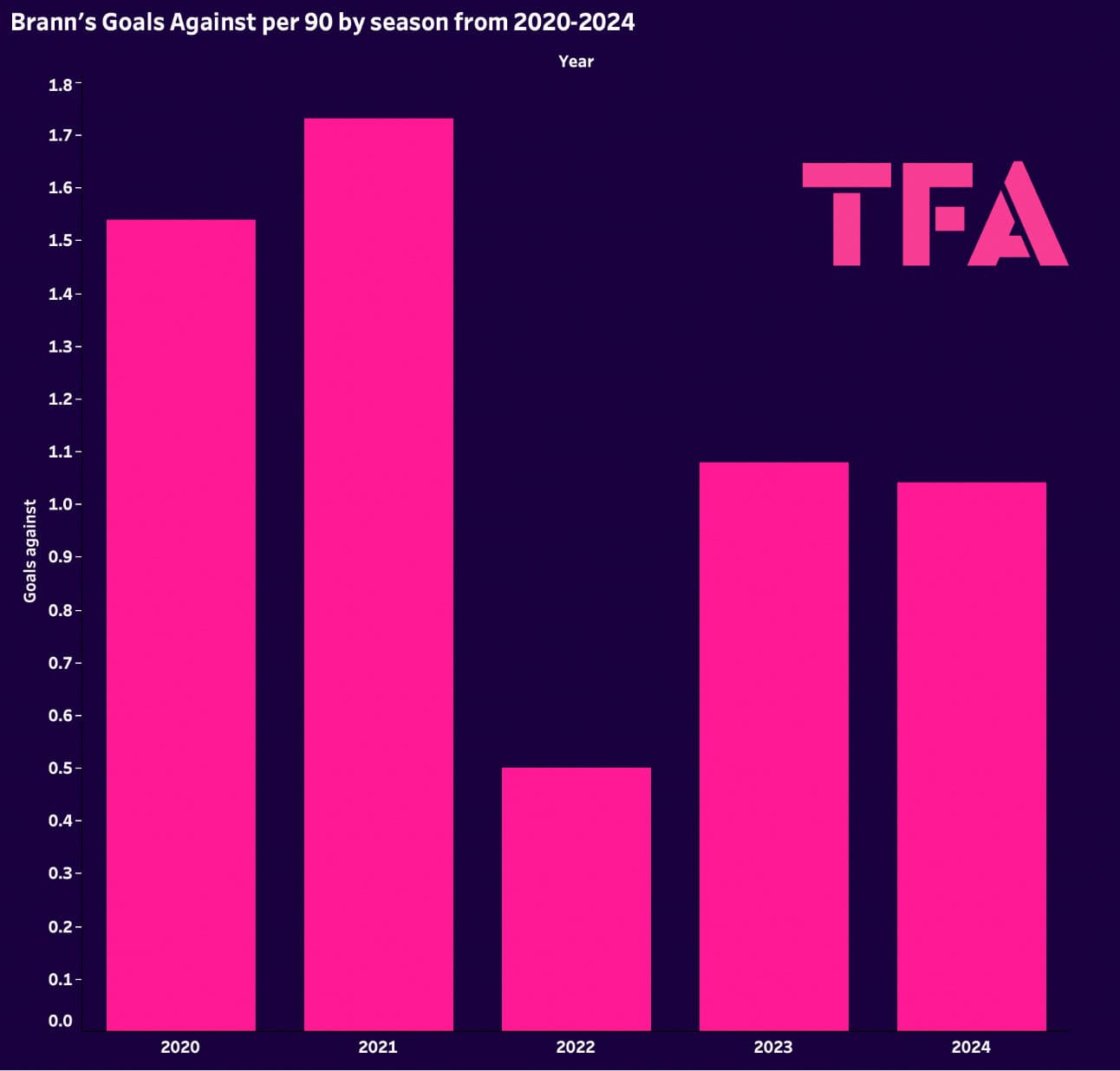
Horneland’s reign as Brann boss has been characterised by a strong defence.
Looking at figure 2, we can see that their average goals conceded per 90 has dropped considerably from 2020 and 2021 to the last couple of seasons, decreasing from a high of 1.73 per 90 in 2021 to a far more respectable 1.04 per 90 this season.
They’ve gone from having the third-worst defence in 2021 to the fourth-best in 2024.
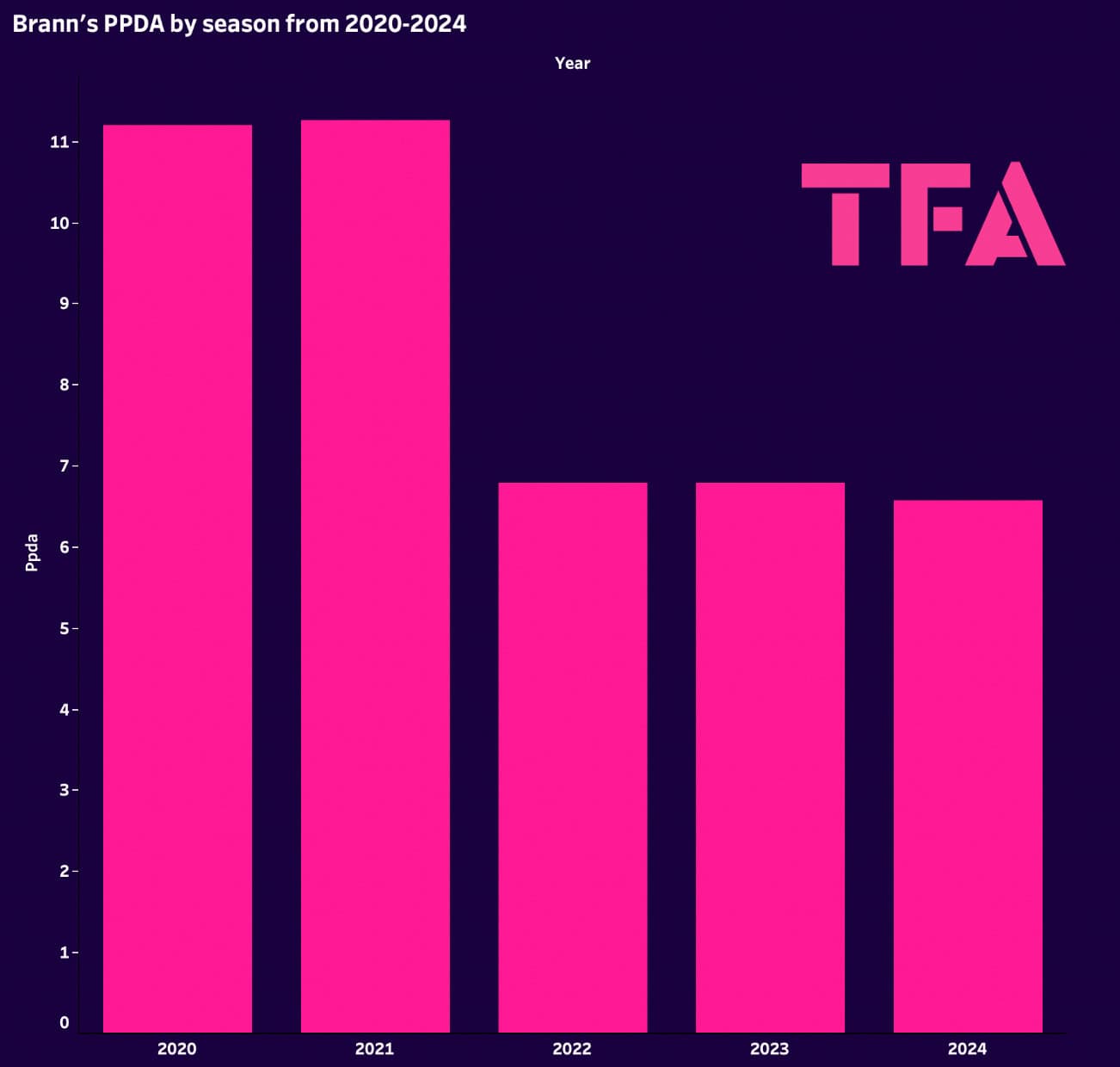
Behind the improved results and stronger defensive record has been a stylistic shift in favour of higher pressing intensity.
Figure 3 displays Brann’s PPDA numbers by season from 2020 to the current campaign.
PPDA is effectively a solid indicator of a team’s pressing intensity — the lower the number, the more aggressive the press.
To sum it up, we can see that the numbers have been slashed by almost 50% during Horneland’s tenure, dropping from 11.25 in 2021 to 6.57 in 2024; this equals a fall from the league’s 10th-highest pressing intensity in 2021 to by far the Eliteserien’s most aggressive press in the current season.
Overall, the data shows a clear improvement in performance at the same time as Brann have undergone a significant tactical shift in the defensive department.
Aggression In Pressing And Counterpressing
So, how does this tactical shift look on the pitch?
Our tactical analysis is divided into three distinct sections, beginning with our ‘aggression in pressing and counterpressing’ section.
Each section targets a specific principle of Horneland’s pressing philosophy.
First up, we’ll focus on how Horneland’s side displays aggression in their out-of-possession approach.
You wouldn’t need to watch much of Horneland’s Brann for the word ‘aggressive’ to come to mind — they clearly embody this trait in their out-of-possession actions.
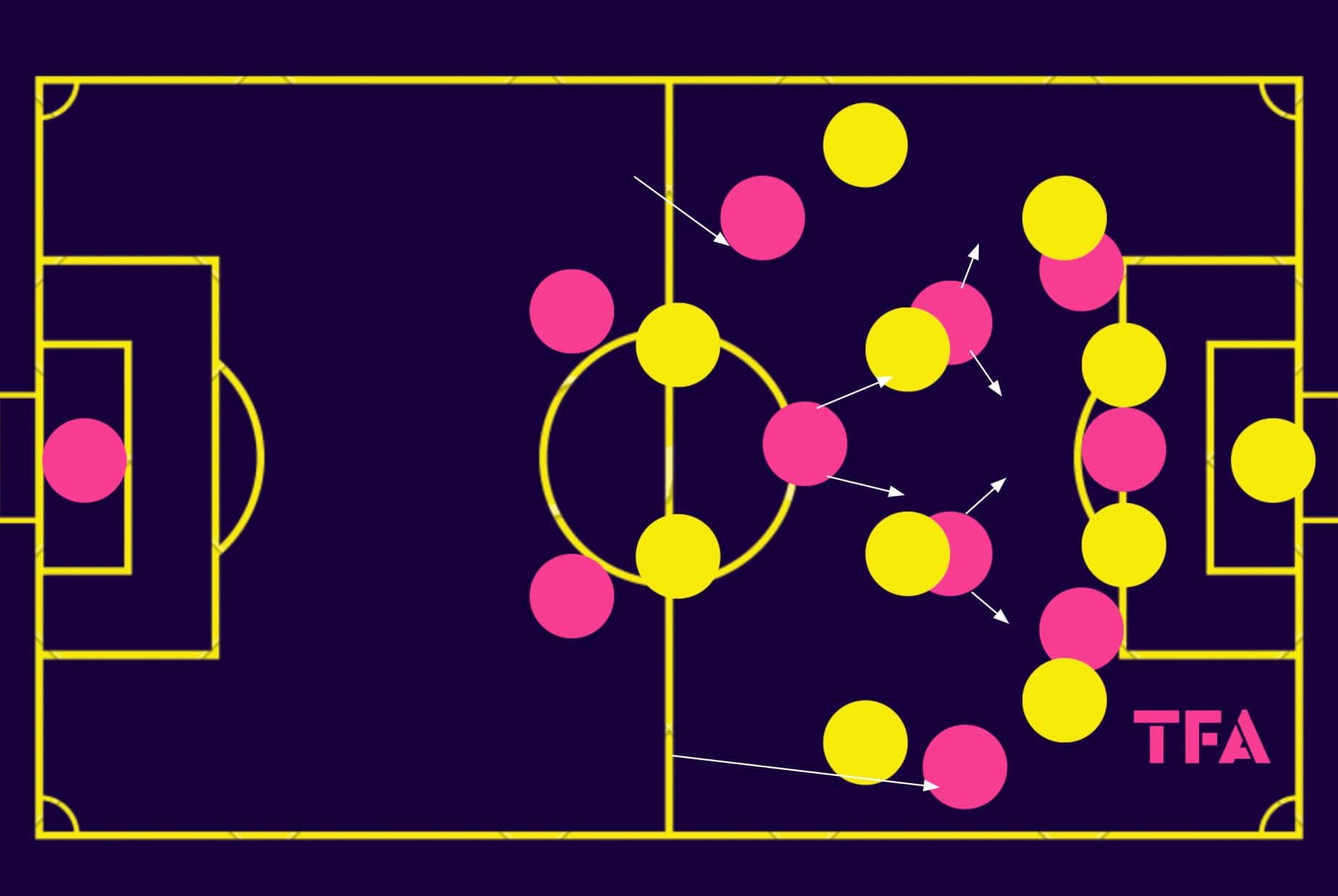
Horneland typically sets his team up in a 4-3-3 shape, both in possession and out-of-possession.
Generally quite ball-dominant, we see an example of how they might look when on the ball and setting themselves up inside the opposition’s half in figure 4.
Now, you may be asking why we’re talking about how they shape up in possession when we’ve stressed that this is a tactical analysis piece centring on what Brann do without the ball — and that’d be a fair question.
Defending begins in possession, with the team setting themselves up in a specific shape on the ball to try and break the opponent down and score.
They must also be prepared to counterpress should a loss of possession occur—this is something Horneland’s side does at a very high level.
As illustrated in figure 4, it’s more common to find Brann’s right-back higher.
At the same time, the left-back tucks inside next to the holding midfielder, leaving a 2-2 ‘box’ at the base of the formation, with the left-back, holding midfielder and two centre-backs; these deep-lying players are crucial to the team’s transitional defence.
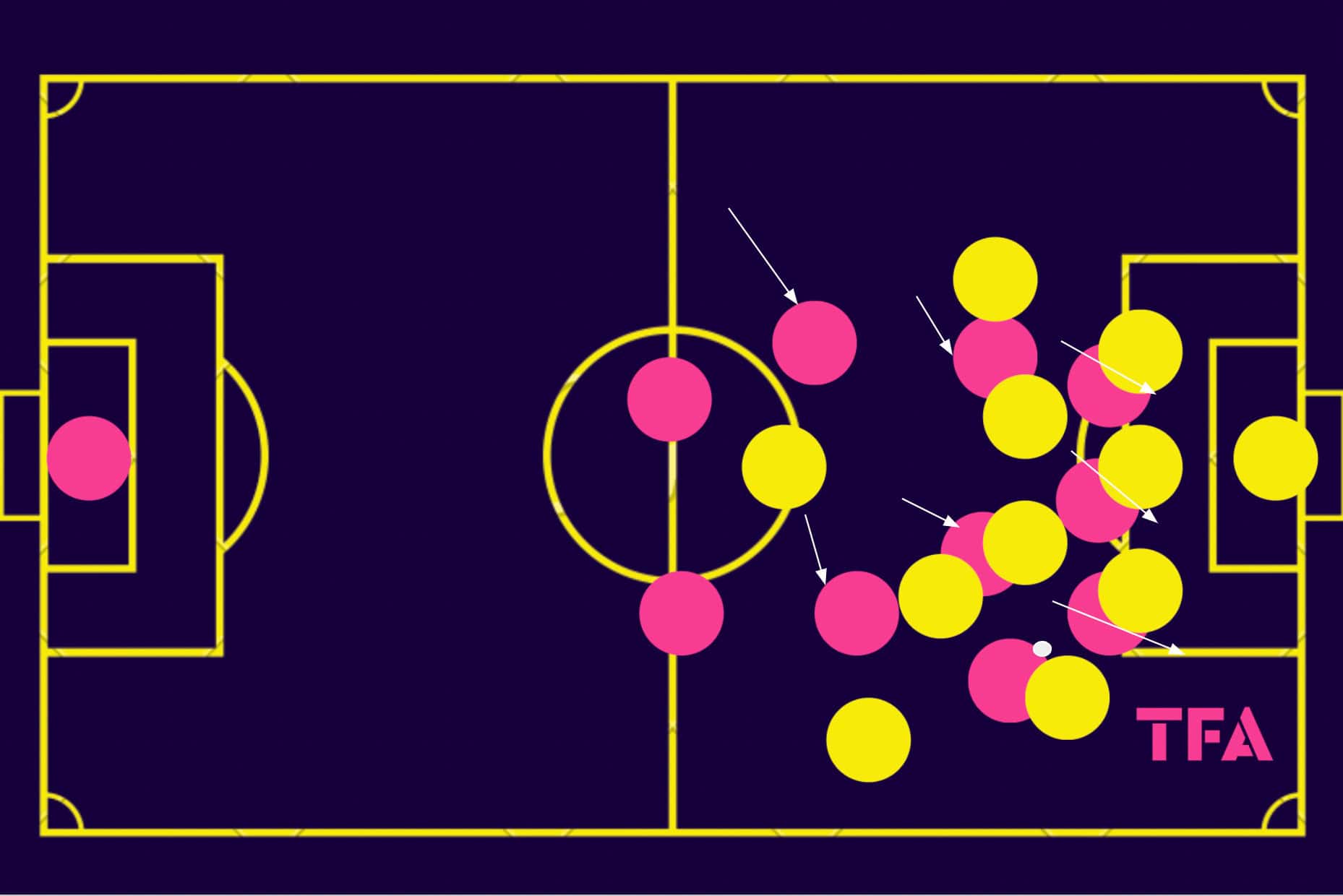
In figure 5, we see a real example of how Brann formed this 2-2-3-3/2-2-6 rest-defence shape in a recent Eliteserien game.
Here, we find the right-back — normally Svenn Crone — on the ball in the final third with the attacking three and the two more advanced central midfielders trying to provide options in the final third.
Meanwhile, the holding midfielder has dropped out to support via a deeper option.
It’s common we find Brann getting quite narrow in attack, sacrificing width on the ball-far side for extra support around the ball-carrier.
They have frequently deployed natural centre-back Ruben Kristiansen at left-back this season as a result, valuing his ability to read the game and playing him in this role that sees him tuck in to guard against the transitional threat.
With players positioned very close together in the final third, this sees Horneland’s side score plenty of their goals via intricate passing plays and link-up between players.
At the same time, crucially, this also means that plenty of Brann bodies will usually be around the ball should a turnover occur, meaning they’re often well-placed to counterpress aggressively.
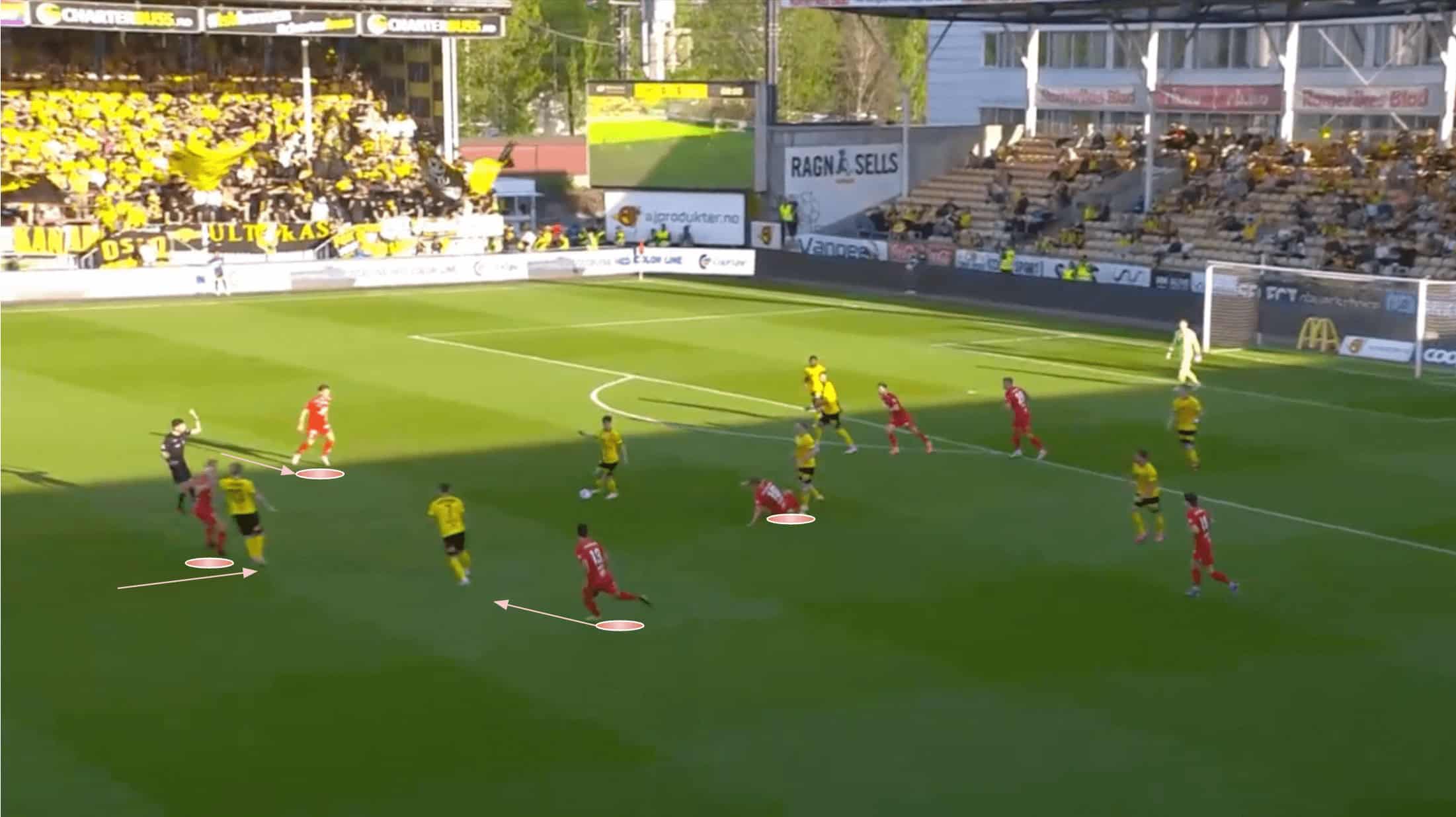
Figure 6 presents an example of one instance where Brann have lost possession inside the final third but have several players positioned near the opponent, ready and willing to try and win the ball back quickly.
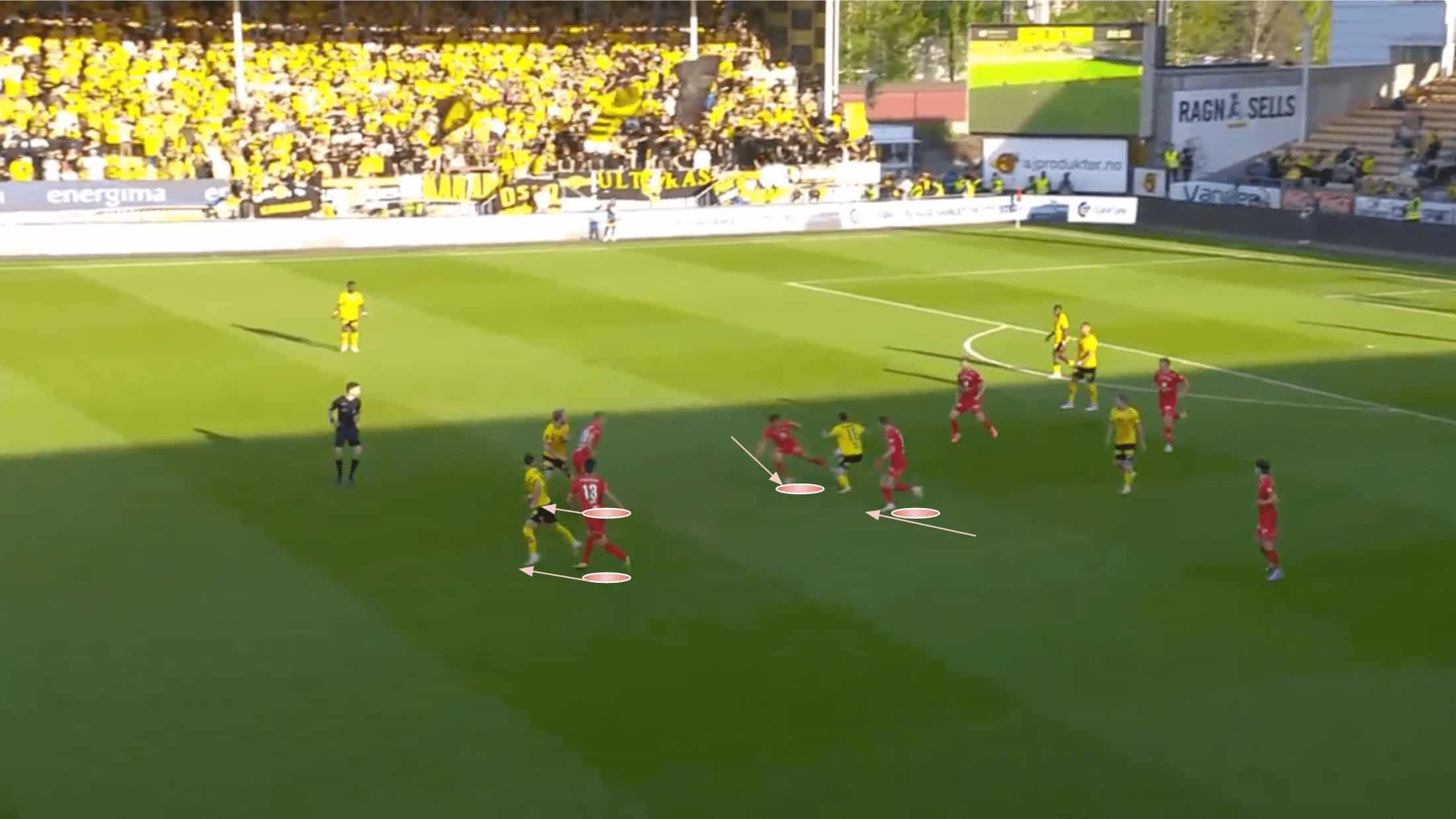
That’s exactly what occurs in this case, thanks to the players’ diligent and intense pressing, good positioning, speedy reactions, and discipline to keep the nearby passing options covered.
This gives the player nearer to the ball carrier time to close down and get within range for a tackle.
In total, Brann have made 421 counterpressing recoveries in Norway’s top-flight this season — a total which exceeds the counterpressing numbers of any other team in the league.
This goes to highlight just how much emphasis is placed on well-organised transitional defence in the Horneland camp.
Indeed, on the flip side, with intense pressing and counterpressing comes high risk.
Suppose the opponent can get past the onslaught of Brann bodies that will be swarming them on a turnover of possession.
In that case, Horneland’s side can be vulnerable at the back, especially as the holding midfielder can be drawn high as the team launches its counterpress, with the focus on closing down space near the ball carrier.
Brann’s centre-backs must be good in 1v1 duels, as they’ll often be called into action to step out and defend the space in front of them if the holding midfielder is caught out of position on the counter.
Still, the opponent can find ways around them at times, and when they do, this can be exploited to create a goalscoring opportunity.
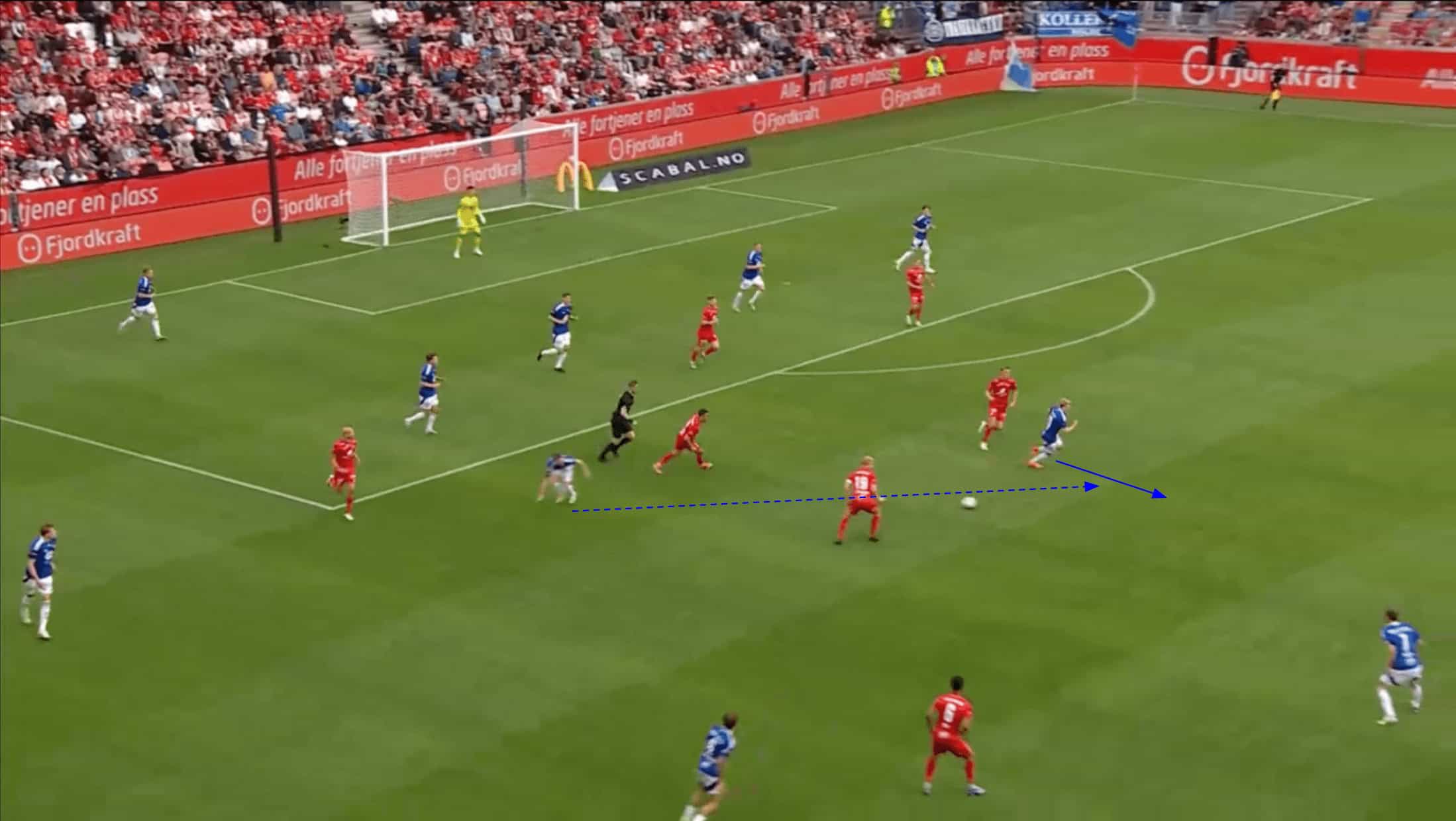
Figure 8 shows one example of Brann being played through on the counter immediately after a turnover, with an opponent finding space in the middle of the park.
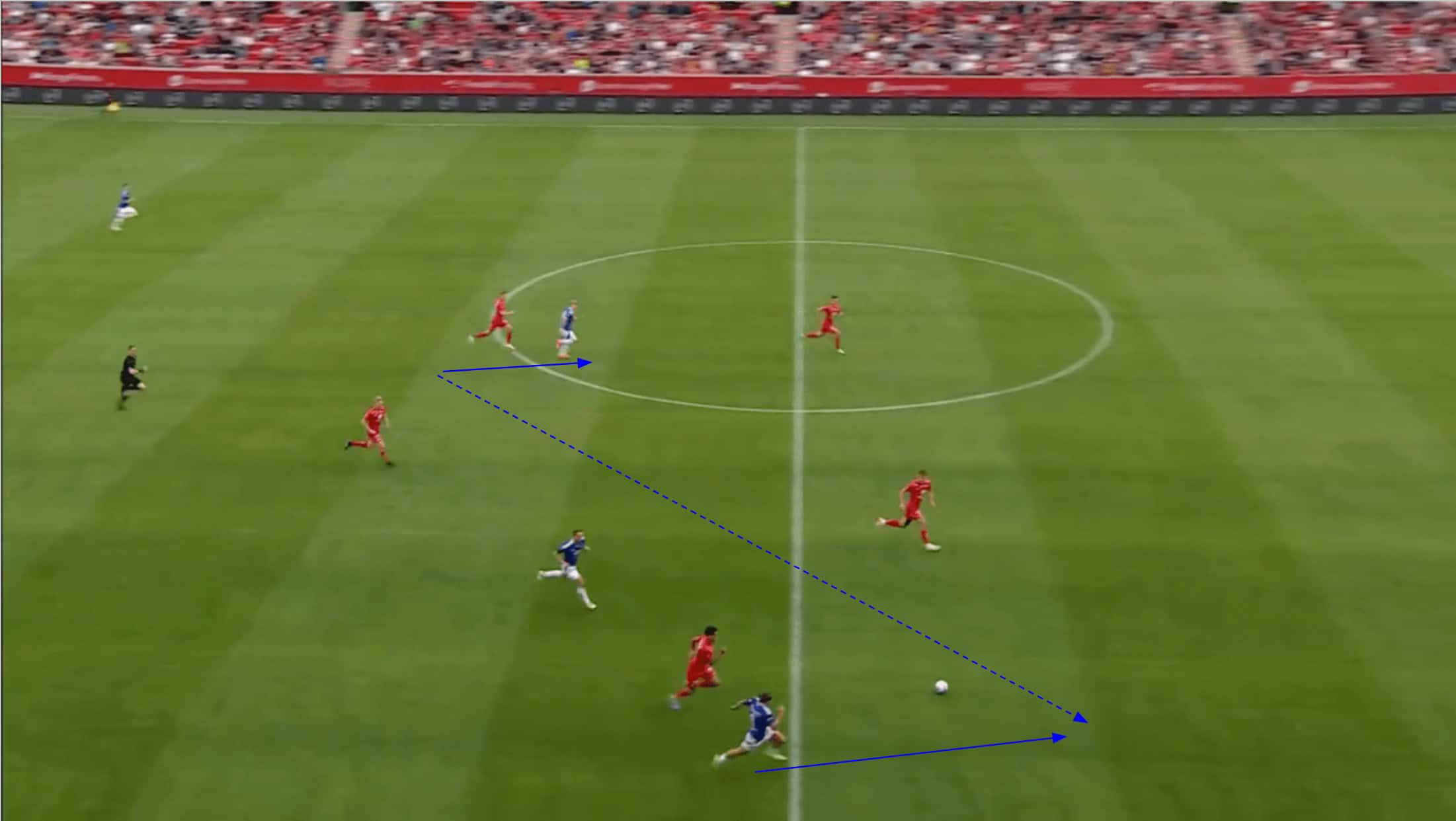
As play moves on, we see that the ball carrier manages to find a teammate sprinting down the right flank via a through ball, helping the team get in behind Brann and progress all the way into the final third as this counterattack continues.
Protecting The Centre
Protecting the centre of the pitch — the most valuable parts of the pitch as far as creating threat is concerned — is vital.
Horneland and Brann do this partially through their positioning and spacing in the centre, with a strong zonal marking system which gets more man-oriented in the middle of the park at play.
In their rest defence, they protect the centre by sacrificing width on the ball-far side of the pitch and instead asking the ball-far full-back to tuck in and essentially act as a second-holding midfielder.
They’ll also frequently add numbers to the centre of the pitch in the mid-block phase as the centre-forward drops in to pick up the opposition’s holding midfielder, effectively creating a diamond midfield.
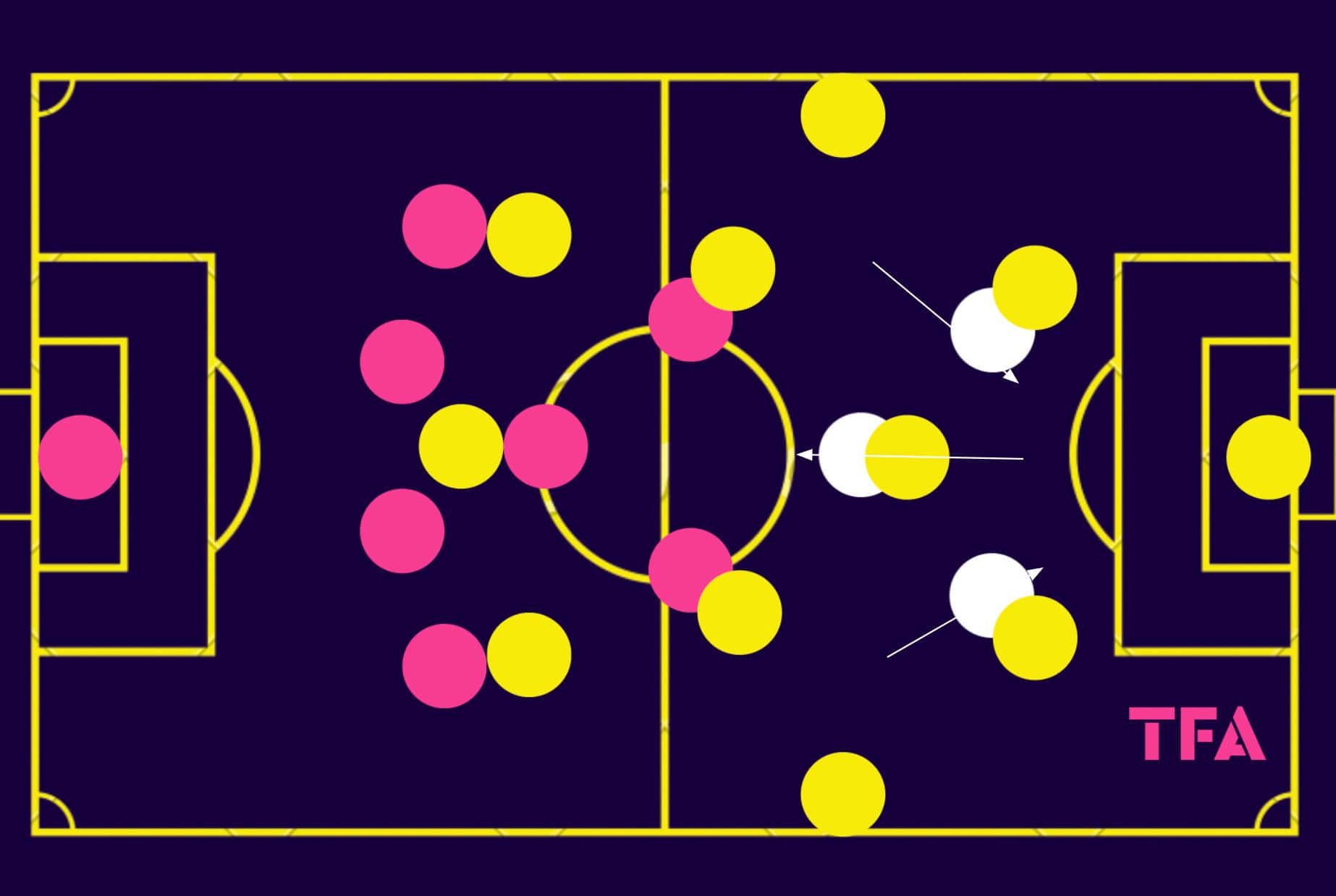
Figure 10 illustrates how this would look: the centre-forward drops into midfield, now acting more like a ‘10’ to pick up the opposition’s holding midfielder, while the wingers come narrower and essentially act like right and left strikers.
This often gives Brann an extra man advantage in the middle of the park, aiding their ability to prevent the opposition from playing through those valuable central areas.
However, it does leave ‘Bergens Stolthet’ vulnerable to switches of play out to the wing.
This is where a lot will be asked of the wingers and wide central midfielders, who must be ready to react and cover the space out wide, as well as the full-back, who will often have to jump to a higher position to cover the switch out to the wing.
This means the rest of the defence must be synchronised in how they shift over to that side of the pitch and, crucially, switch the marking of certain players off to one another as they move.
If done incorrectly or with miscommunication, this could lead to an opposition attacker becoming free in a dangerous area.
Still, Brann’s priority is controlling the centre of the park to prevent being played through from the most valuable areas of the pitch and applying intense pressure to the ball carrier so they can’t comfortably play that big switch.
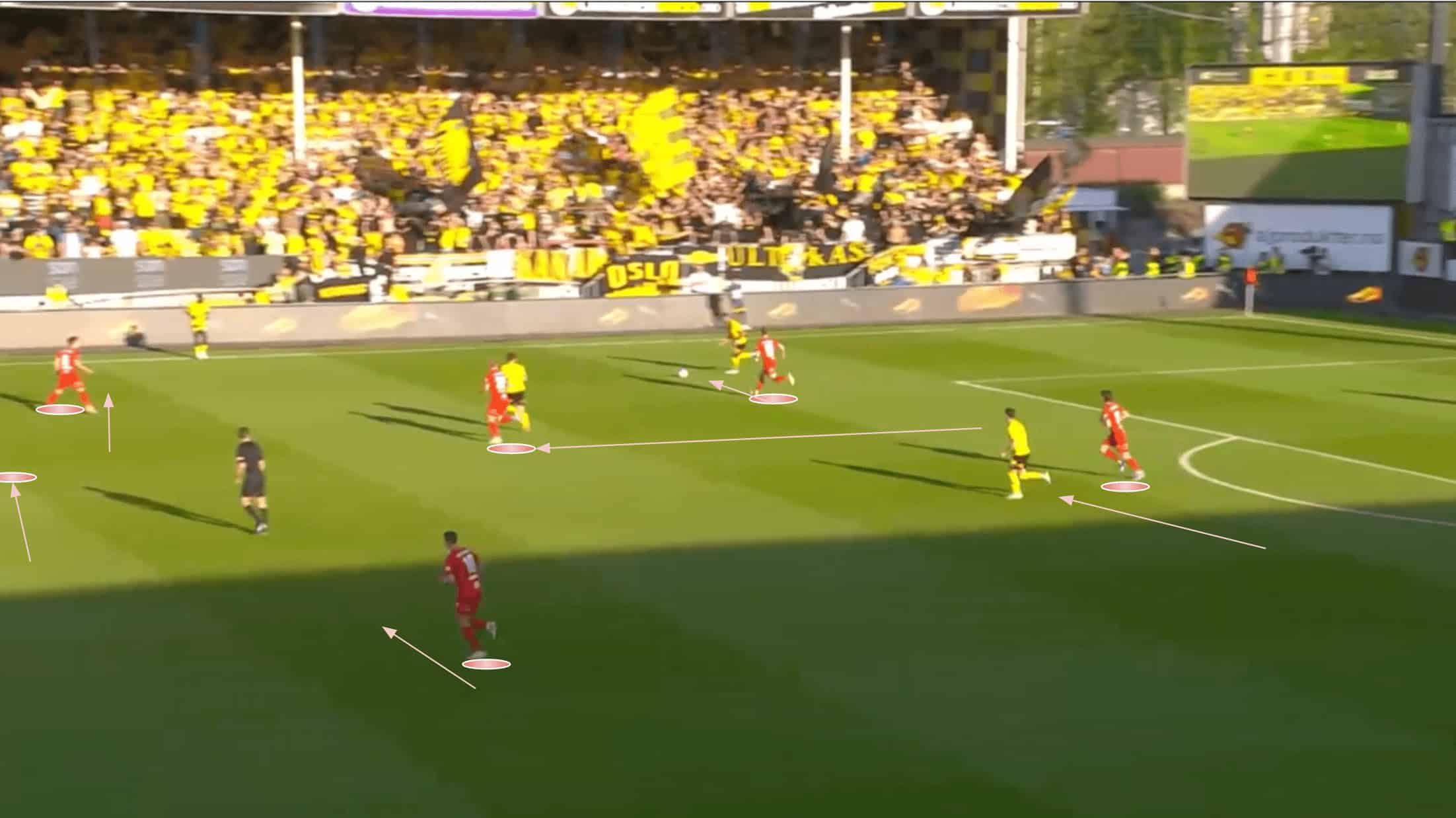
Figure 11 shares an in-game example of how Brann’s shape looks when converted into a diamond midfield with the striker dropping into a ‘10’ position.
On this occasion, we see that they’ve forced play out fairly wide, with the left winger pressing the opposition ball carrier — their right centre-back — while keeping the other central defender — who’s also being marked by the other winger — in his cover shadow.
The centre-forward man marks the opposition’s holding midfielder, the left central midfielder retains access to the opposition’s right-back, the right central midfielder retains proximity to the rest of the midfielders to keep the diamond shape intact and, just out of shot, the holding midfielder has shifted across to cover any potential progressive passes through the centre targeting the attackers.
As this passage of play moves on, we see that the holding midfielder’s anticipation and reading of the game come in clutch, as the opponent does try to play a progressive pass towards the attackers through the centre of the pitch.
The holding midfielder cuts this pass out and kickstarts the attack for Brann again, highlighting the value of the packed centre that Horneland’s side created.
Active Midfielders
The third and final essential aspect of Brann’s defensive tactics we’re going to analyse in this piece is the activity levels of their midfield three.
Indeed, their wingers must be quite active without the ball to contribute to the team’s press, while the centre-forward must be at least positionally aware.
However, it’s in midfield where the players’ activity levels are most vital and where fitness is a major necessity due to the workload the players in the middle of the park have to take on.
On top of this, it’s essential that the midfielders are tactically aware and don’t just press like headless chickens; they need to understand the right pressing triggers and the importance of pressing as a unit, not as individuals, which is where Horneland’s coaching quality is evident in his team’s output.
Holding midfielder Sivert Heltne Nilsen was crucial to Horneland’s tactics throughout the coach’s time at Brann, but he departed earlier this summer for Scottish Premiership side Aberdeen — a significant loss for Horneland and his tactics.
Since Nilsen’s departure, Horneland has tried out different shapes, including a double-pivot, essentially highlighting how important his profile of a highly fit, aggressive, yet intelligent defensive midfielder was for the out-of-possession tactics Horneland advocates.
Emil Kornvig, more of a central midfielder, has recently taken on the task of replacing Nilsen at the base of Brann’s midfield, and that seems to be the plan, at least for the moment.
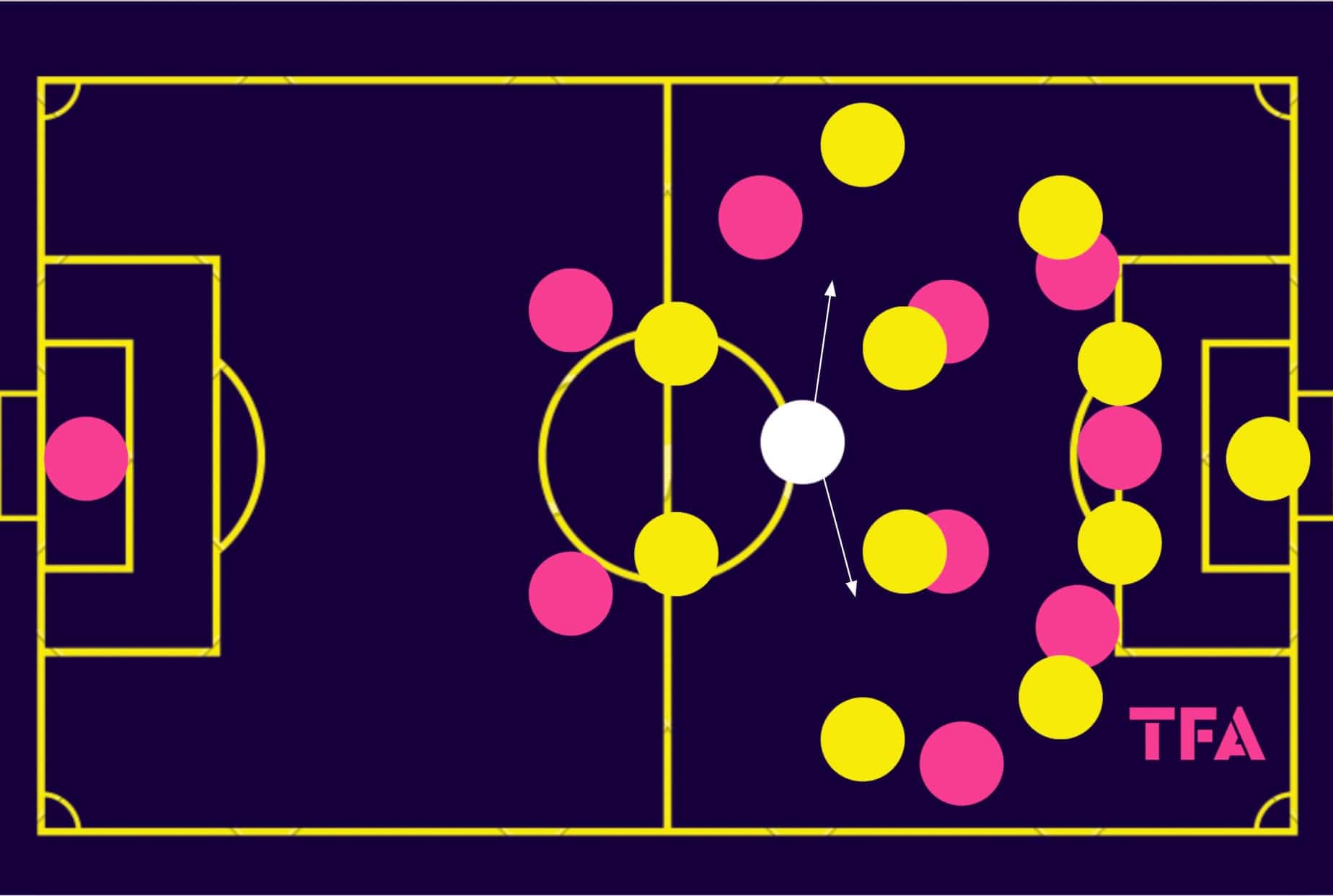
The holding midfielder needs to be excellent at reading the game and prepared to cover a lot of ground but not get caught out of position too often — a very tricky balance to get right and a role which Nilsen performed to an incredibly high standard for the Eliteserien level; the 32-year-old midfielder played a significant role in Brann’s elevated performances during Horneland’s tenure.
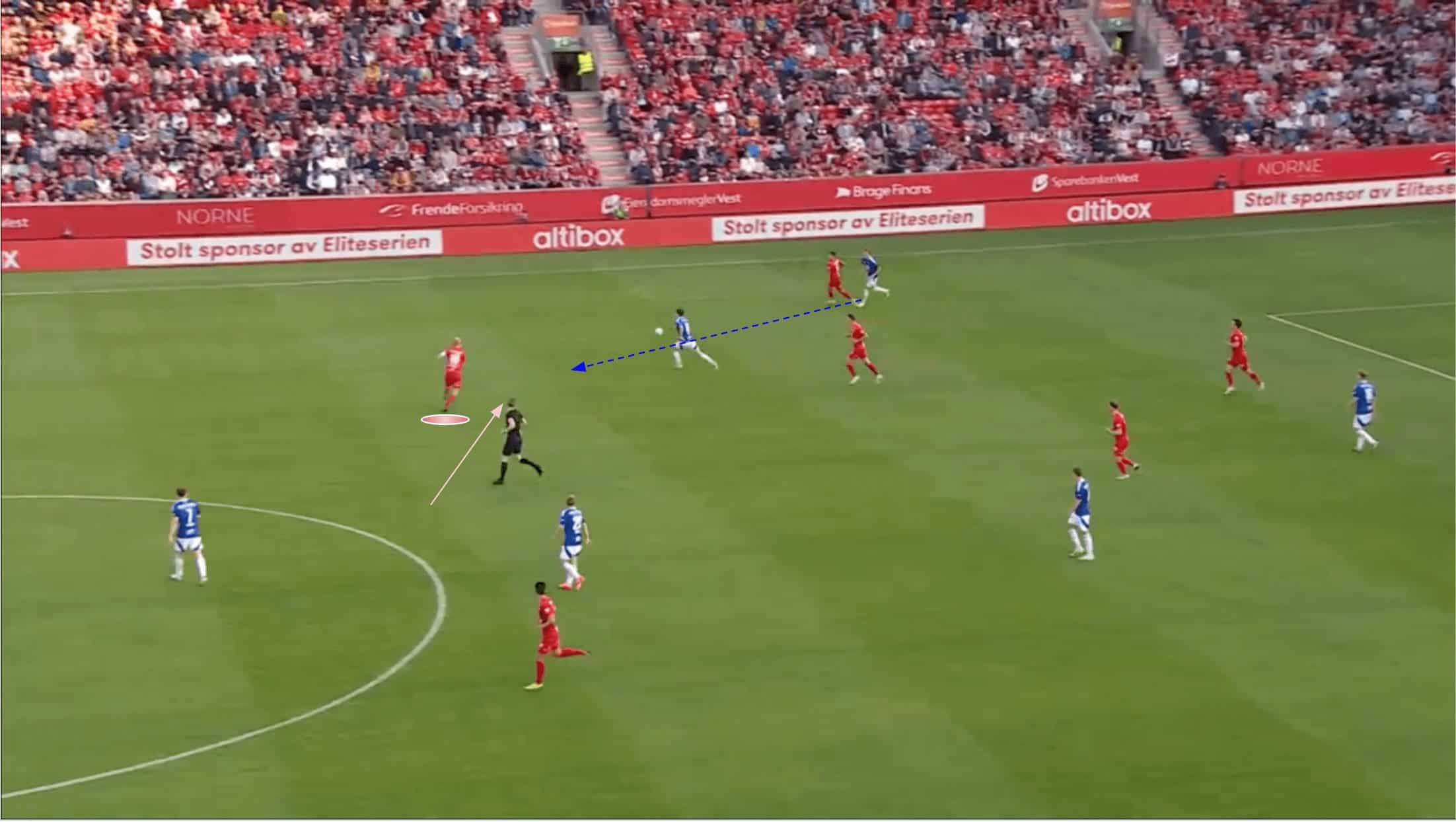
When pressing high and counterpressing, the holding midfielder has to be ready to press on the front foot like the rest of the midfield but still remain aware of what’s going on around and, crucially, behind him to avoid leaving an obvious gap for the opponent to exploit.
He needs to be able to spot danger early within a fairly large radius of his starting position and be quick enough to close that danger down to regain possession for his side.
From his time in Eliteserien this season, Nilsen has generated the most successful defensive actions per 90 (11.67) of any midfielder in Norway’s top flight for the 2024 campaign, emphasising his highly active role in the defensive phases.
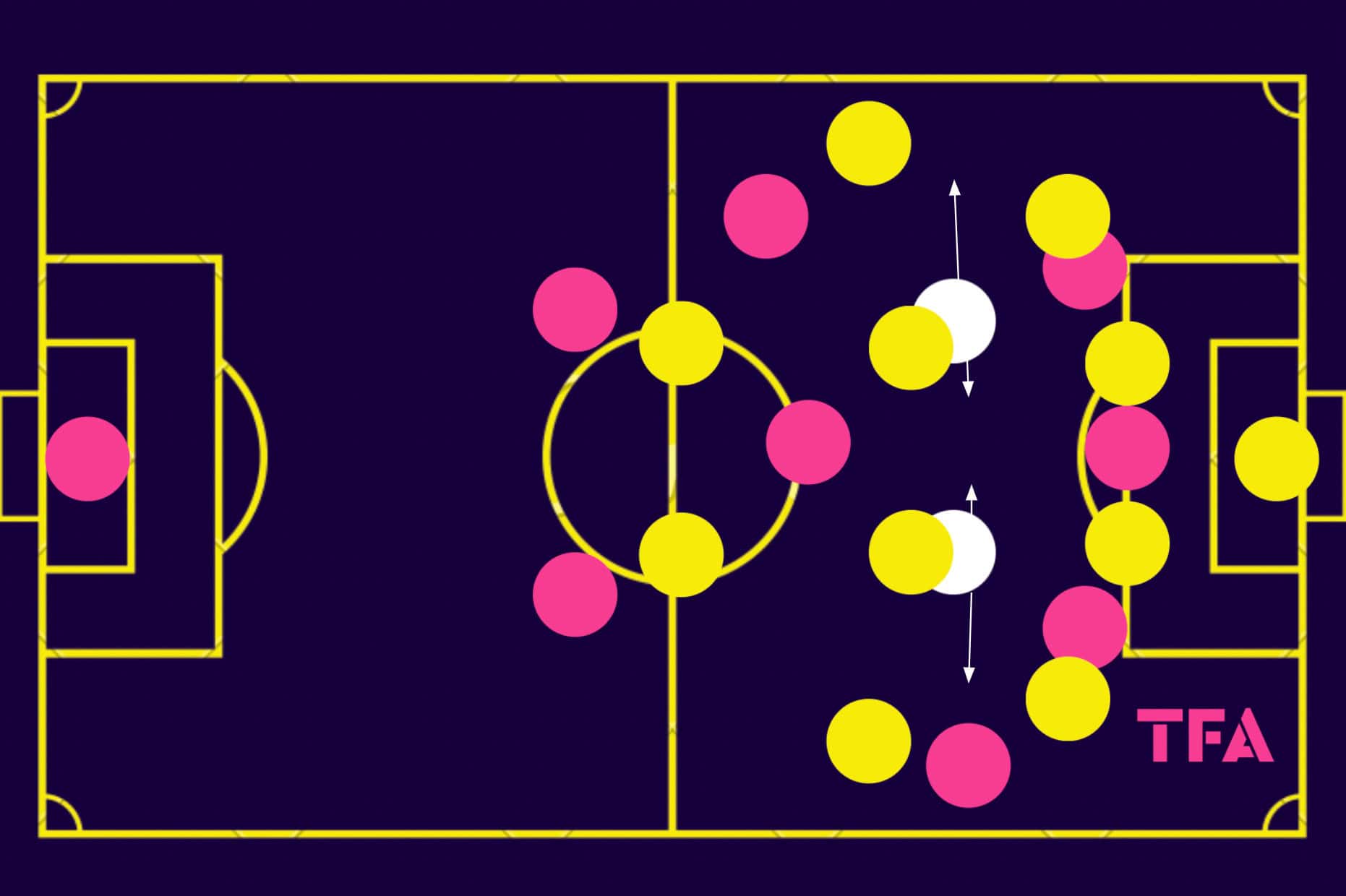
It’s not just Brann’s holding midfielder who needs to make a major shift without the ball—the central midfielders also need to do so.
Particularly in settled defensive phases, the holding midfielders need to be prepared to cover wider areas, supporting the full-back and allowing their back four to remain tight and compact.
If they fail to do so, gaps can be forced and exploited by the opponent in Brann’s backline as the full-back is forced wide.
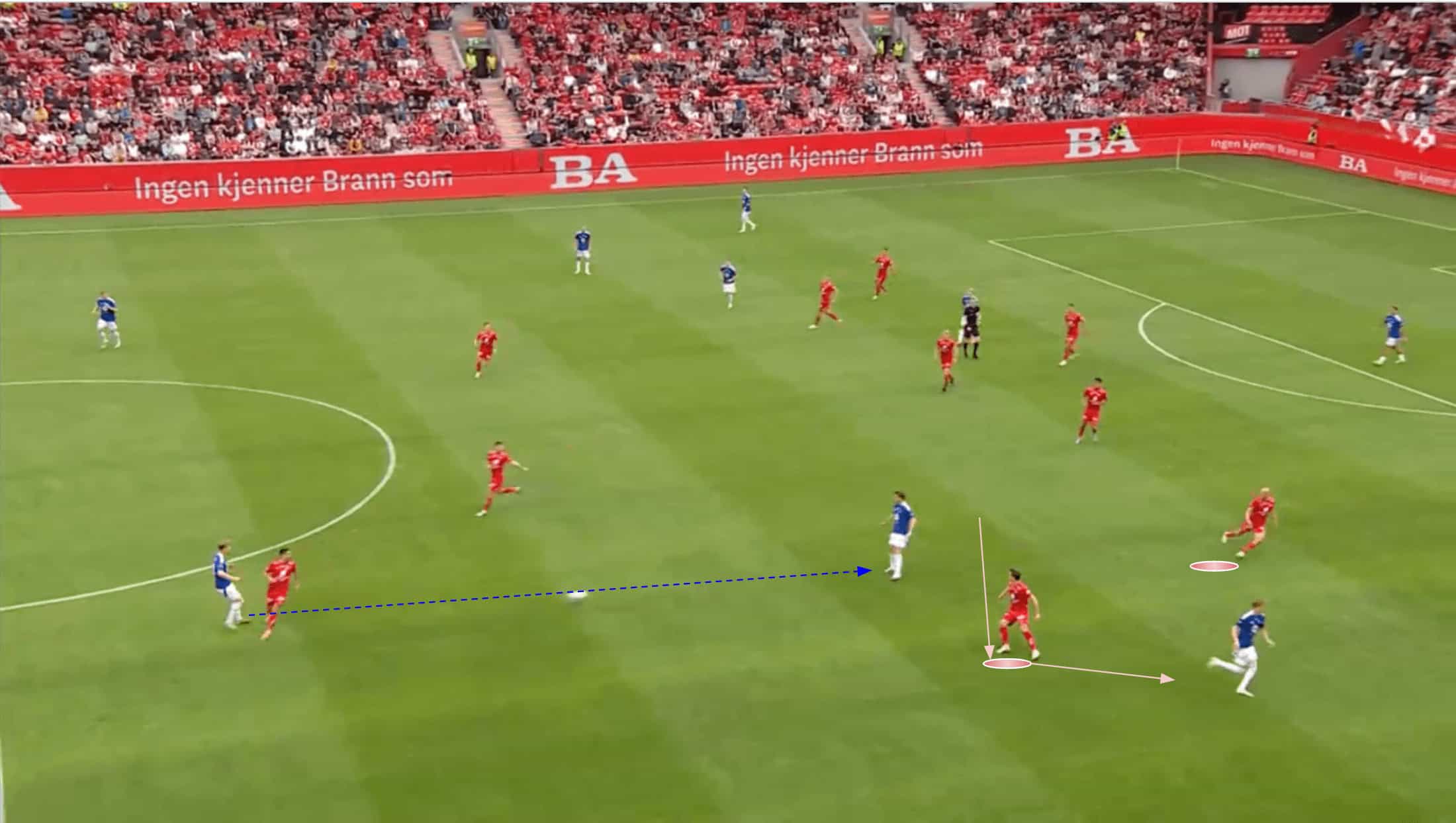
Cohesion is crucial to a successful pressing side, not just between players in the same horizontal line, as we’ve touched on earlier in this piece, but also those in the same vertical line.
We see Brann’s left central midfielder trying to cover the pass out to the opposition’s right-winger.
However, the overloaded midfielder is caught out as the pass is actually played towards the centre of the pitch.
As the ball carrier managed to squeeze the ball past the pressing Brann body and into the middle of the park, they would’ve thought was being protected via the cover shadow of the higher player.
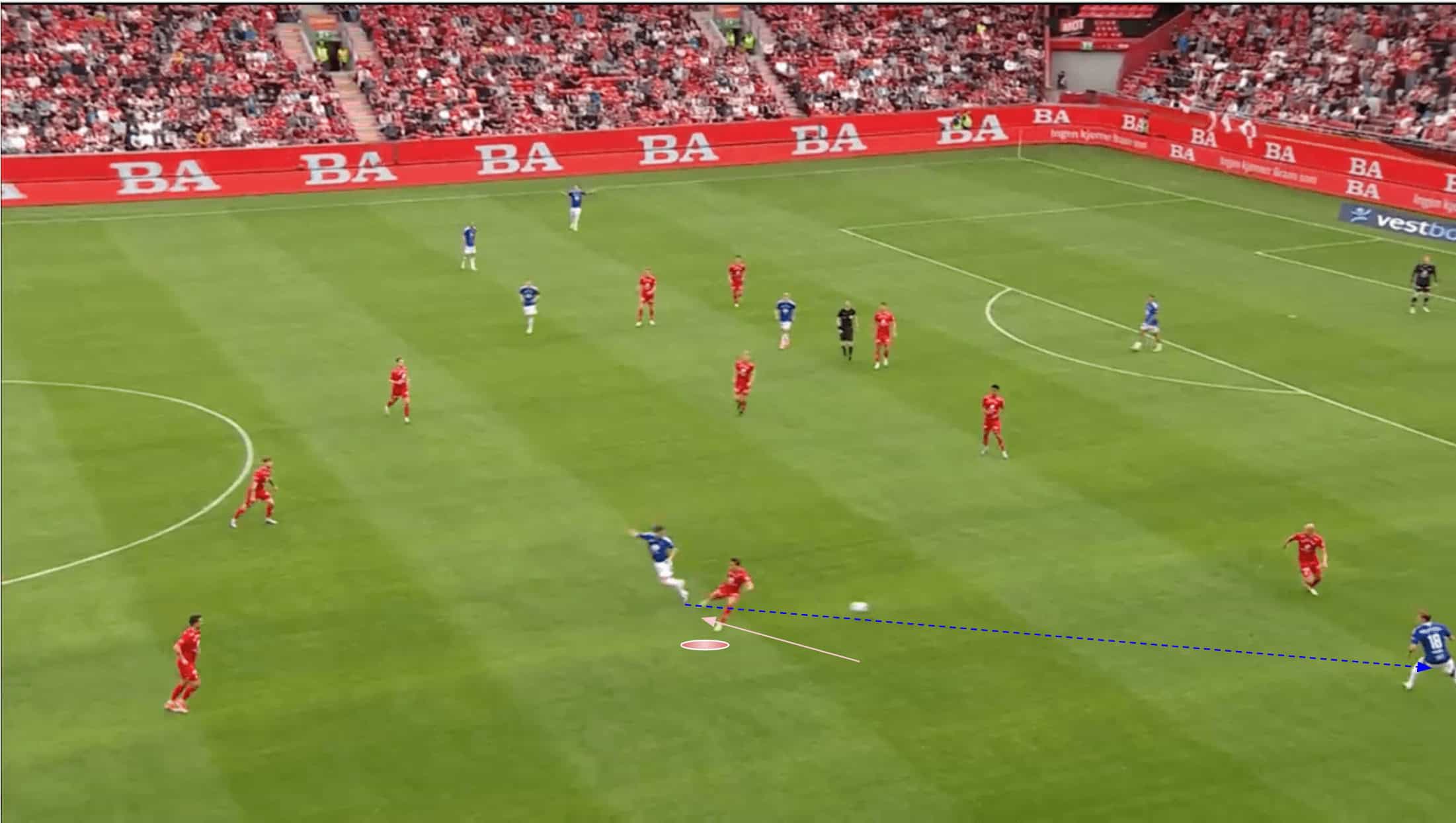
Keeping calm, knowing where you need to go, and knowing how your teammates will react are all key qualities of a well-oiled, cohesive team.
Figure 16 provides a great example of how Horneland has generated this within his Brann side.
As the left central midfielder reacts to the pass and closes down the opposition receiver in midfield, the left-back shifts out wide to cover the winger.
The ball-carrier tries to find the winger, thinking he may be free as the Brann midfielder has turned his attention to him, but his through ball is cut out by Brann’s left-back, the experienced Kristiansen, who reads the game well, exhibiting excellent timing and understanding with his midfield teammate.
The midfielders’ active role involves taking on quite a few tasks, which can also cause them to get overwhelmed at times.
However, their teammates have covered for them on plenty of those occasions, as the general understanding and cohesion within Horneland’s team is very high, facilitating the stacked roles that the midfielders perform out of possession.
Conclusion
To conclude this tactical analysis, it’s clear that Horneland’s Brann tenure has seen him quickly supercharge the team’s performances, especially out of possession.
He’s moulded the team into his image as an intense, aggressive, high-pressing unit.
The team’s cohesion and understanding without the ball are key to the successful implementation of Horneland’s high-pressing tactics, ensuring they result in high turnovers and not disorganisation most of the time.
It’s a credit to the 49-year-old’s coaching ability that he’s managed to get the team pressing so aggressively and so effectively with consistency over a few seasons now.
This has resulted in the team going from Norway’s second tier to the brink of European football in just a couple of seasons.

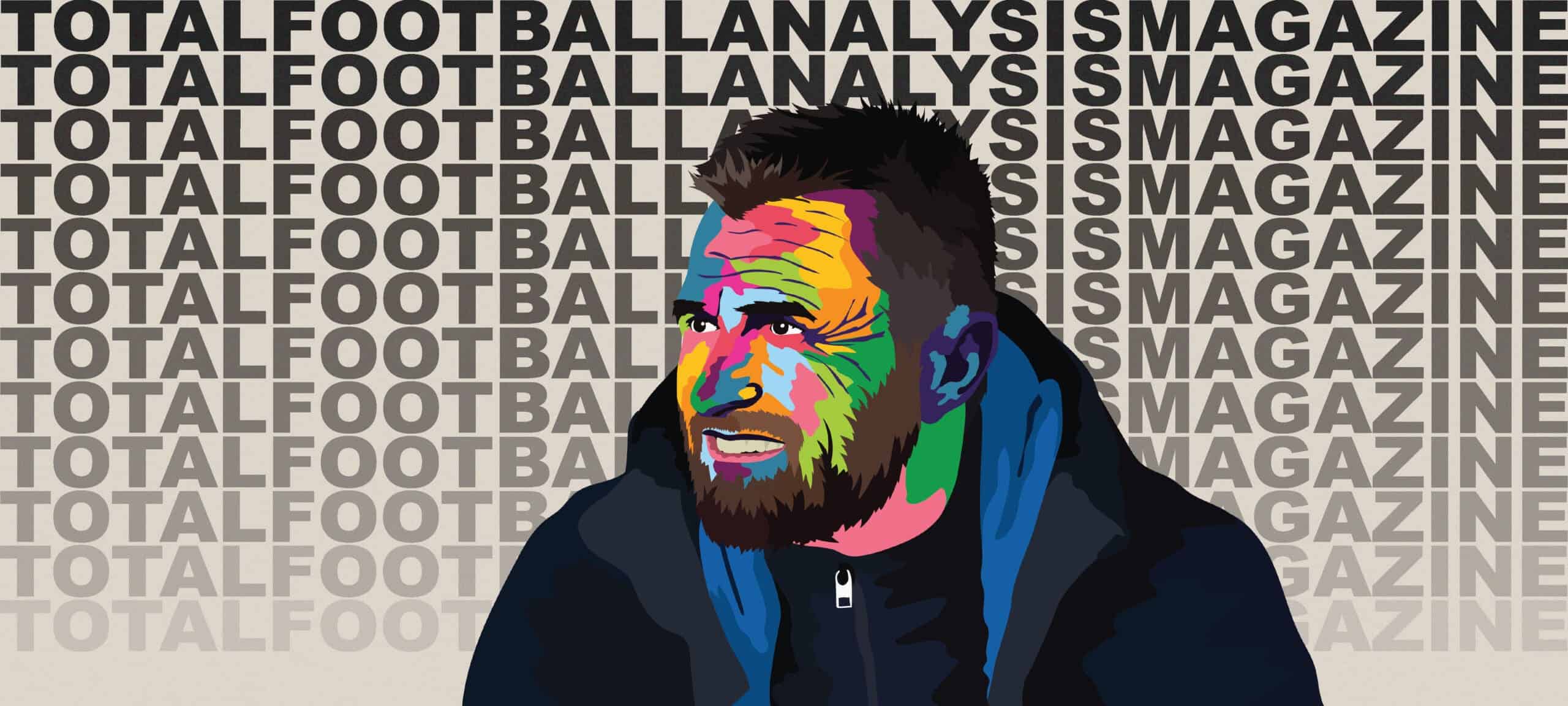



Comments